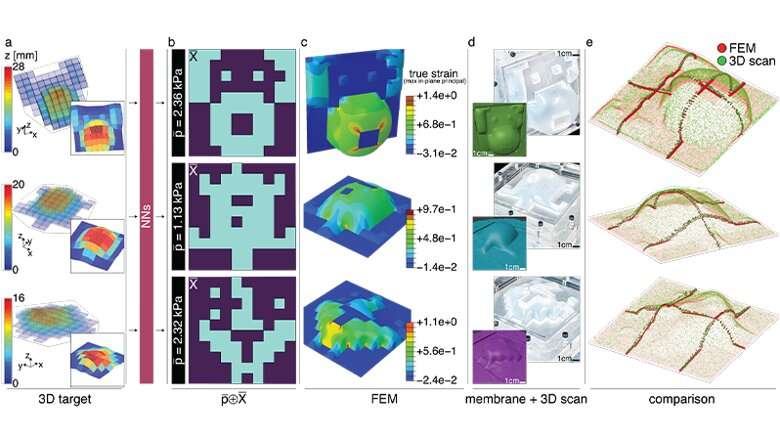
From 2D to 3D: How to inflate shapes via machine learning

Research by King’s Lecturer in Engineering, Dr. Antonio Forte, is investigating ways of working with soft robots to allow them to morph from two to three dimensions. This paves the way for devices that can be programmed to inflate to a precisely customized shape that will meet a specific need. The research is published by Advanced Functional Materials.
Until now machine learning methods have been mainly used for image recognition and language processing. More recently they have emerged as powerful tools to solve mechanics problems. The work of Antonio and his colleagues shows that these tools can be extended to study the nonlinear mechanics of inflatable systems.
The research involved building multimaterial membranes made of soft or stiff square pixels. The researchers present algorithms to generate three classes of soft membranes, where the pixels cluster in different ways, creating various deformed inflated shapes. They design and optimize a model that learns how the mutual position of each pixel in the grid contributes to the global mechanics of the system.
Commenting on the findings, Antonio says, “We show how our platform has potential to design patient-specific devices for mechanotherapy and beyond. Before this research we didn’t know how to use machine learning to unravel nonlinear mappings in inflatable systems. It turns out that they are very powerful for these purposes. The work has potential in many areas, for example in treating tissues around scars to promote healing.”
The success of the research so far has led the team to consider further developments, for example, morphing three dimensional shapes into new three dimensional forms.
Programmable balloons pave the way for new shape-morphing devices
Antonio Elia Forte et al, Inverse Design of Inflatable Soft Membranes Through Machine Learning, Advanced Functional Materials (2022). DOI: 10.1002/adfm.202111610
Citation:
From 2D to 3D: How to inflate shapes via machine learning (2022, January 11)
retrieved 11 January 2022
from https://techxplore.com/news/2022-01-2d-3d-inflate-machine.html
This document is subject to copyright. Apart from any fair dealing for the purpose of private study or research, no
part may be reproduced without the written permission. The content is provided for information purposes only.
Stay connected with us on social media platform for instant update click here to join our Twitter, & Facebook
We are now on Telegram. Click here to join our channel (@TechiUpdate) and stay updated with the latest Technology headlines.
For all the latest Technology News Click Here
For the latest news and updates, follow us on Google News.

